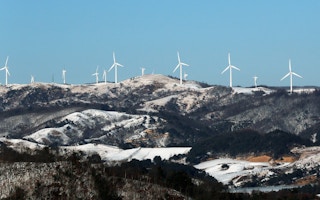South Korea’s people, who breathe dirtier air than any other rich nation around the world, are the very obstacle standing in the way of clean energy technologies in the country due to their fear of environmental ills that renewables could bring, according to a new report by a Seoul-based non-profit.
To continue reading, subscribe to Eco‑Business.
There's something for everyone. We offer a range of subscription plans.
- Access our stories and receive our Insights Weekly newsletter with the free EB Member plan.
- Unlock unlimited access to our content and archive with EB Circle.
- Publish your content with EB Premium.
To be clear, weak power grid infrastructure and lack of support remain stumbling blocks for renewables in the East Asian nation. Upgrades of transmission lines and substations move forward at a snail’s pace, subjecting developers to wait times of up to two years before they gain grid access, with currently over 6 gigawatts of projects affected. Cash flows for production of green electricity can fluctuate, creating financial uncertainty.
But how renewables can thrive at all, when developers face vehement resistance from local residents loath to see their surroundings marred by wind and solar farms, is the bigger question looming over the industry.
As the share of renewables in the country’s fossil fuel-dominated power mix grows, conflicts between clean energy companies and communities have been on the rise in recent years, prompting policymakers to curb developers’ access to land and delay or even reject projects, according to the analysis by the non-profit Solutions for Our Climate.
“Obtaining development permits from local governments is a major challenge for renewables in Korea, and that’s because the industry faces a public acceptance issue in local communities,” said Solutions for Our Climate’s director Jeehye Park.
South Korea may be the most polluted wealthy nation in the world, but while citizens associate coal with the choking air they breathe, they fail to see renewables as a way to address the issue, she said.
The report comes as new data shows that South Korea last year installed more coal-fired power capacity than any other member of the Organisation for Economic Cooperation and Development (OECD), contributing to the biggest annual increase in global coal capacity since the historic Paris climate deal.
Fuelling resistance to renewables is the spread of exaggerated claims and false rumours related to their environmental impacts. Despite government efforts to correct misinformation, concerns over toxic minerals and the health effects of electromagnetic waves have gained ground, says the report, titled Not Yet Renewed: Challenges in Renewable Energy Transition in South Korea 2020.
Conservative politicians and newspapers have tarnished the image of clean energy, making people believe that renewables are not the answer to climate change, but the country’s declining nuclear industry has played the biggest role, said a local energy expert, who wished to remain anonymous.
Tentative transition
The new report comes on the heels of an announcement by the country’s ruling party for South Korea—the world’s seventh-largest carbon dioxide emitter—to deliver net zero emissions by 2050. In 2018, solar photovoltaics and wind accounted for less than 2 per cent of total electricity generation in the country.
But the renewables target enshrined in South Korea’s latest energy plan—to ramp up their share to 30 to 35 per cent by 2040—is not ambitious enough to tackle air pollution and meet the nation’s climate commitments, said Park.
This lack of ambition reflects doubts among engineers, grid operators and authorities that the country can upgrade its power grid and energy storage facilities, such as batteries or pumped storage, to accommodate more wildly fluctuating clean energy supply quickly enough, she told Eco-Business.
However, the target was adopted without taking into account technological advances and the falling costs of renewables, storage and grid operation technologies, observed Seung Wan Kim, assistant professor at the Department of Electrical Engineering at South Korea’s Chungnam National University. By 2023, the cost of solar electricity is expected to achieve grid parity with conventional sources of power, shows the new report.
If the nation is ever to be largely powered by clean energy, authorities will need to rethink grid operations and energy markets, the report added. Energy consumers equipped with their own installations, for instance, could become power producers, selling energy to their neighbours, provided the government implements the business models needed.
This will require far-reaching reforms and conducive policies, noted Park. “We don’t expect to see them until after the next presidential election.”
Get the people on board
On much of South Korea’s rural flatland, life has never been easy for clean energy developers. Local authorities have been reluctant to hand out land for anything but farming.
But in response to public concerns, authorities have severely restricted sites available for renewables. Firms have been mandated to put minimum distances—sometimes 1 km—between their installations, roads and residential areas. This has made it nearly impossible to find any land to develop. “There are no such restrictions for nuclear or coal power plants,” said Park.
Offshore wind projects face similar opposition. Coastal dwellers are worried that turbines could wreak havoc on fishing grounds, sparking fears among industry players of new curbs on maritime development, the new report shows.
Not all concerns voiced by communities, such as the fear of solar farms encroaching on forests, are unfounded. But tree-felling to clear space for photovoltaic panels is the result of inadequate environmental management and policies failing to bar energy companies from entering forested areas, Park told Eco-Business.
To dispel residents’ concerns, communities must be involved in planning and decision-making. Another way to increase public acceptance of renewables is support for people-led clean energy projects, the report said.
There is also a rethink of adverse regulations underway. South Korea’s National Assembly is currently mulling over programmes that would allow agriculture and clean power production to co-exist.
Park said: “If the government really wants to achieve net zero emissions, it needs to make it clear that society must provide the room for renewables to grow.”










